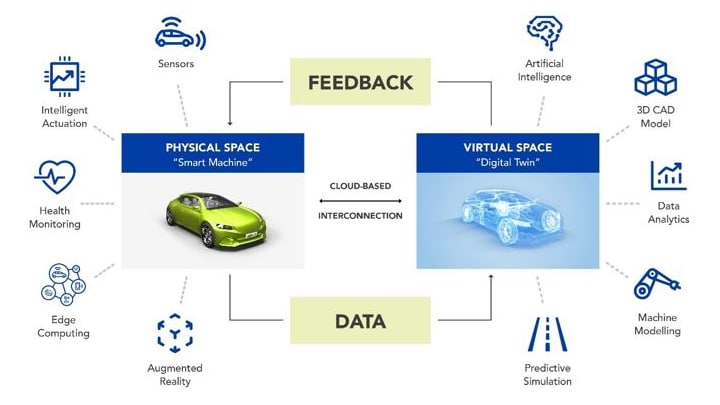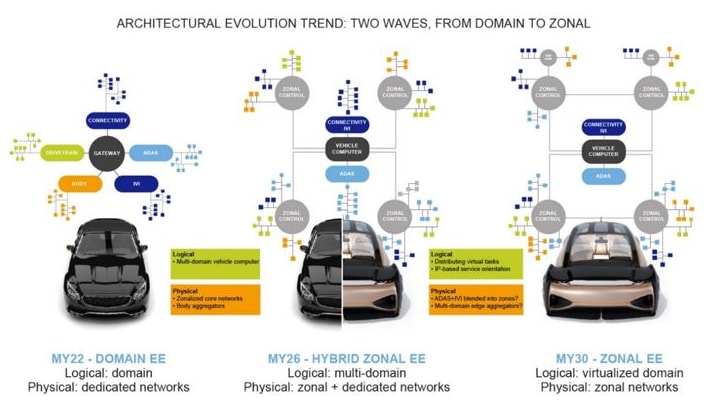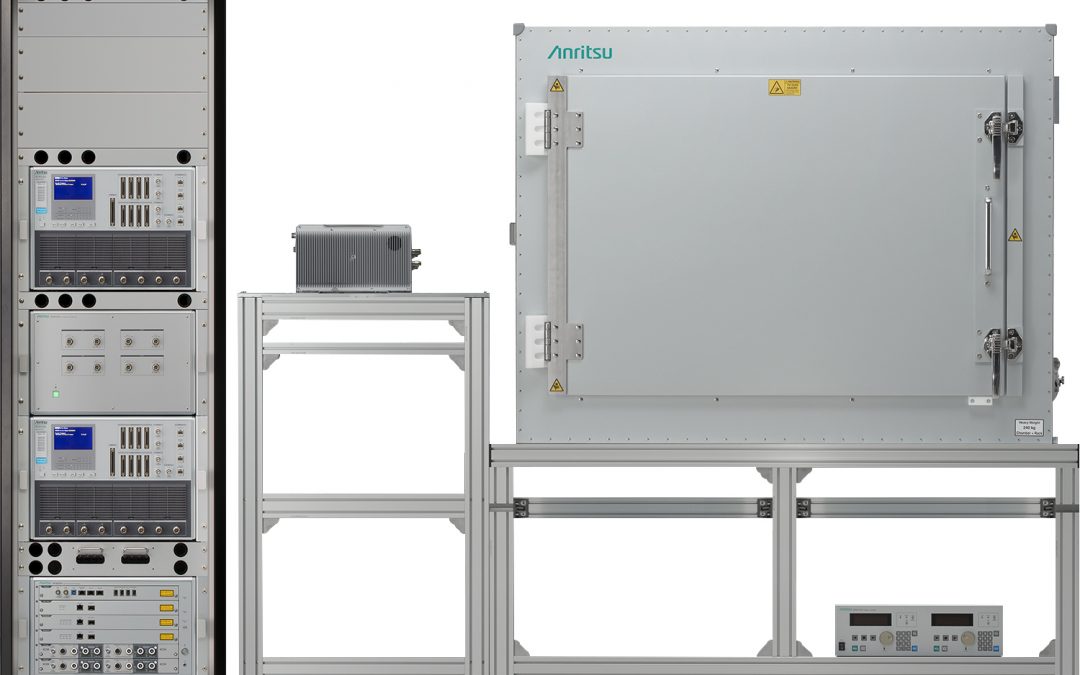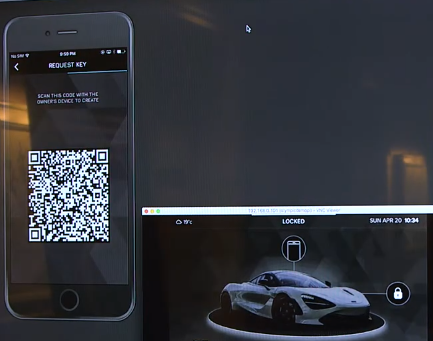With new trends such as electrification and autonomous driving, today’s vehicle can be described as a system of sub-systems
Somewhere in Los Angeles in the United States, the Department of Transportation is partnering on a solution to create a data-driven digital twin of the city’s transport infrastructure1. In other places across the world, the automotive use cases of digital twins are expanding. The automotive industry is indeed one of several industries that have integrated the use of digital twins, given its far-reaching capabilities.
With new trends such as electrification and autonomous driving, today’s vehicle can be described as a system of sub-systems that is continually evolving and that often have different electronic modules—sometimes up to 100 or more. The intricacy of the sub-systems underpins the need for their real-time virtual representation. This is exactly what digital twin is about: a virtual replica of a physical object or system that can be used to simulate real-world conditions and test different scenarios in a virtual environment. It monitors and reflects a physical object through the use of sensors, machine learning and artificial intelligence. Each type of digital twin has its unique capabilities and benefits and can be used together to create a comprehensive digital model of a vehicle.
| Unit-level digital twin | At the lower hierarchical level, this can reflect a component of equipment, material or environmental factor. |
| System-level digital twin | This comprises several unit-level digital twins in a production system or a complex physical product. |
| System of systems (SoS) level digital twin | Several system-level digital twins form SoS-level digital twins, which enhances collaboration across the supply chain, design, service and maintenance, among others. |
Digital Twins Are Big on Data
Digital twins do not only generate vast amounts of data about a physical object but also need data captured from the physical object to provide its full capabilities. In automotive, sensors are fixed on several parts of a vehicle to produce and relay a large amount of data about the vehicle’s functionality and status. The data flow is a crucial part of modern digital twins and can provide several benefits throughout the lifespan of the vehicle.
 Figure 1. Ingredients and features of the digital twin ecosystem
Figure 1. Ingredients and features of the digital twin ecosystem
Monitoring of vehicle components is one particular benefit that data availability enables. An example is the tracking of the battery’s state-of-health (SoH) which can be vital in correcting anomalies. Similar to SoH, digital twins can also help track the remaining useful life (RUL) of vehicle components. While SoH might help the automaker manage battery charging and thermal controls for the component, among others, RUL could help an insurance company assess the value of a damaged vehicle or alert the owner to order a new component. For instance, if a battery system has minimal RUL, then the battery might be replaced and repurposed for another application.
All these possibilities require huge amounts of data. Although digital twins’ reliance on data is not peculiar to automotive, modern vehicles have become more complex, underlining the crucial role the technology can play. These complex vehicles are not only producing more and more data but also need the data to be refined and relayed as quickly as possible for optimal performance.
Some Changes to Vehicle Architectures
Vehicle architectures must become more flexible to accommodate the bi-directional transmission of data. Specifically, there is a need for high-performing in-vehicle networking (IVN) to meet the processing requirements for increased data usage. A growing trend in this regard is a shift toward Zonal EE architectures.
Spreading vehicle functions over the network, Zonal EE architecture allows the localization of issues to specific parts of the vehicle architecture. This enables faster response and error ratification. Digital twins can reside either close to the vehicle-end nodes (near actuators and sensors), more centralized in the high-performance compute clusters or live in the connected cloud. Latency and decision response times dictate where the digital twins should reside. Tooling and processing capabilities, that allow porting of the functions and digital twins across the signal-to-cloud space, enable system developers to easily migrate features.

Additionally, by increasing the processing power in the central vehicle computer, zonal E/E architectures enable vehicle innovations that are driven by software and over-the-air updates. The zonalization of architectures simplifies the integration of data from multiple sources, which can be a boost in the use of digital twins.
Vehicle Prototyping, Performance Optimization and Other Benefits
Virtual prototyping, although complicated, provides clarity on how vehicle components will function together in different scenarios. For OEMS, digital twins do not only facilitate virtual prototyping but also provide more possibility to upgrade vehicle designs, deploy new features and consequently reduce costs. By gathering and analyzing operational data, they simulate the performance of vehicles and share insights on potential improvements. This can yield multiple benefits for optimizing the performance of vehicle components.
One such benefit is improved battery management for extended battery life. Using AI-powered solutions makes adjustments to any change in battery health possible, thus enabling continuous improvements especially to control decisions. This enablement can help overcome major concerns for EV batteries and BMS that include improving EV range, ensuring battery safety and increasing battery lifespan.
Besides BMS improvements, there is also an added advantage of predictive maintenance that allows for the monitoring of vehicle components and systems in real-time. This data can be used to predict when maintenance is needed, which reduces downtime and maintenance costs. Other use cases of the technology in the automotive industry include simulating the behavior of autonomous vehicles in different driving scenarios. This possibility helps to refine and test the software and hardware components of autonomous vehicles before they are deployed on the road.
Overall, the use of digital twins in automotive will be more widespread, particularly as the digitization of vehicles continues to unfold. Its use in the industry has the potential to improve product design, manufacturing processes and maintenance of vehicles, leading to better products and a more efficient and reliable automotive industry. As this evolution continues, a key priority will be meeting the requirements for functional safety and cybersecurity across various automotive processes.
Related Articles

Anritsu, Sony Semiconductor validate industry first Non-Terrestrial Network (NTN) NB-IoT testcase
First NTN NB-IoT Protocol Conformance Tests for have been validated on the 5G NR Mobile Test Device Platform Anritsu Corporation has announced that the first NTN NB-IoT Protocol Conformance Tests for has been validated on the 5G NR Mobile Device Test Platform ME7834NR...

Ellisys Introduces Support for CCC Digital Key Technology
Protocol Updates Aid in Test, Validation, and Debug for Automotive and Consumer Electronics Developers and Test Labs Ellisys, a leading worldwide provider of Bluetooth®, Universal Serial Bus (USB), Ultra-Wideband, and Wi-Fi® protocol test and analysis solutions has...

Leveraging UWB and BLE in Manufacturing Environments
Manufacturing processes are being revolutionized by pin-point tracking and monitoring, leading to optimized workflows and enhanced safety protocols within the factory environment Manufacturers are always on the lookout for innovative solutions to transform their...
Stay Up to Date With The Latest News & Updates
Our Sponsors
Incisor.TV partners with leading organisations in the technology sector.
Follow Us
And stay up to date with our news! We are active across the key social media platforms – please do follow us!





0 Comments